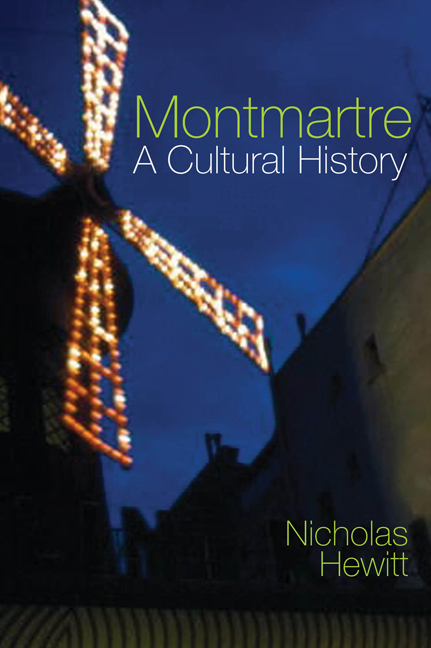Book contents
- Frontmatter
- Dedication
- Contents
- List of Illustrations
- Acknowledgements
- Map
- Introduction
- 1 ‘Montons à la Barrière’
- 2 The Artistic Cabarets
- 3 Music Halls and Mass Culture
- 4 Theatre and the Avant-Garde
- 5 The Bateau-Lavoir and the Lapin Agile
- 6 Wartime and the Années Folles
- 7 The Place of Memory
- 8 The Ecole de Montmartre
- 9 The Occupation: Céline and Aymé
- Epilogue: Montmartre on Film
- Bibliography
- Index
- Plate section
5 - The Bateau-Lavoir and the Lapin Agile
- Frontmatter
- Dedication
- Contents
- List of Illustrations
- Acknowledgements
- Map
- Introduction
- 1 ‘Montons à la Barrière’
- 2 The Artistic Cabarets
- 3 Music Halls and Mass Culture
- 4 Theatre and the Avant-Garde
- 5 The Bateau-Lavoir and the Lapin Agile
- 6 Wartime and the Années Folles
- 7 The Place of Memory
- 8 The Ecole de Montmartre
- 9 The Occupation: Céline and Aymé
- Epilogue: Montmartre on Film
- Bibliography
- Index
- Plate section
Summary
On 2 February 1900, Gustave Charpentier's opera Louise was performed for the first time. The opera recounts ‘the love between a young poet and a working-class girl’ who is lured away from her respectable artisanal family by her lover Julien to become the ‘muse de Montmartre’ in the bohemian's ‘cortège du plaisir’. While Charpentier's depiction of working-class life is sympathetic – Louise's mother is described as ‘le fantôme de la souffrance’ (‘the ghost of suffering’) – and critical of bohemia – the mother cries to Louise: ‘tu la connais maintenant la vie de bohème, tu sais ce que c'est: de la misère en chansons!’ (‘you now know what bohemia is: poverty with songs!’) – the opera nevertheless refuses to renounce the bohemian ideal: Louise leaves her grief-stricken parents to return to the Montmartre bohemians, while her father, in a Rastignac-like gesture of rage at the capital, can only utter: ‘O Paris!’ As Jean-Claude Yan suggests, while Louise is anchored in a literary and operatic tradition, Charpentier, who was helped on the libretto by Saint-Pol Roux, stalwart of the Chat Noir, nevertheless manages to subvert that tradition: ‘Gustave Charpentier places his libretto in the tradition of an old repertoire and stereotypes which he plays upon’. The opera is clearly grounded in nineteenth-century evocations of Parisian bohemia, notably Musset's ‘Mimi Pinson. Profil de grisette’ of 1845, and Murger's Scènes de la vie de bohème, and also in late nineteenth-century operatic derivatives, like Puccini's La Bohème and Offenbach's La Vie parisienne. What is interesting, however, is that, while the bohemian relationship between artist and grisette ends in tears in Murger's depiction, by the turn of the century, bohemia is now dominant and successful in Montmartre – at least against its workingclass rivals. In other words, Louise marks a progression over Scènes de la vie de bohème and La Bohème in its celebration of the victory of bohemia over ‘civilian’ life, cruel as that may be, and it is this which constitutes Jean-Claude Yan's ‘subversion’ of the genre. At the same time, Louise represents a significant victory for Montmartre through its annexation of a fictional and operatic domain long considered the preserve of the Left Bank: bohemia depicted by Musset and Murger.
- Type
- Chapter
- Information
- MontmartreA Cultural History, pp. 114 - 144Publisher: Liverpool University PressPrint publication year: 2017



